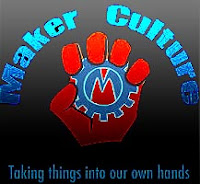Yesterday the Waterloo Region District School Board didn’t cancel school due to inclement weather. The response they got on Twitter was, to say the least, shocking. That students don’t understand how the internet works is apparent in how they present themselves online. Some of their comments not only reflected their ignorance but also uncovered a mob mentality that frequently appears online. Students think they are private and anonymous when they are in fact standing on a world-wide stage making fools of themselves.
 |
| People outside of Kitchener can see Twitter? Dude! |
The fellow on the left is surprised that people not from Kitchener are responding to tweets. The entire world could see these tweets and they’re now a permanent part of the digital record, you can’t take back what was said in anger online. You can only imagine what this does for their digital footprint, not that anyone is teaching them this in school.
My wife suggested that if WRDSB hadn’t let all their elementary librarians go in the last ten years, those librarians might have been there to teach this generation of ‘digital natives‘ how not to make fools of themselves online. I only wish that were true. The vast majority of librarians I’ve met are determined not to address digital citizenship because they feel that technology is a threat to traditional (book based) learning. Alanna herself didn’t get hired recently because she ‘was too digitally focused’. I fear that librarians themselves and the people who hire them aren’t the ones to fix this.
So who does teach digital citizenship? I’ve got a teacher at my school who does it because he feels it’s a vital part of any relevant, modern civics course – he doesn’t even have a full contract. The only people addressing digital citizenship are outliers, though our students (those digital natives) are expressing themselves inappropriately through this technology all the time.
| The mob mentality and the righteousness that comes with it. |
Take a moment to look over the tweets directed at WRDSB in the last 24 hours and you see students making the common mistake (because the formats are similar) of assuming tweets are like texts. In the student’s mind they are texting directly to their school board but, of course, that is not how Twitter works. You see students unaware they they are publishing death threats publicly, you see students encouraging the mob mentality that had them hurling invective at their school board. You have to wonder what a kid in Rwanda thinks about all of these grammar impaired, spoiled, first world kids commplaining about having to go to school. Yes, people in Rwanda can read your tweets.
So we’re left with an awkward, embarrassing situation here, and not one limited to Waterloo Region. We have students who spend the majority of their time in digital communications without realizing what it is or how it works. We have students who are essentially making themselves unemployable by creating such deplorable digital footprints that no one would touch them. Can you imagine what you’d do if you googled the kid who just asked for a job and found death threats against their school board published online? It shows a startling lack of prudence.
Instead of embracing digital communications to create a live résumé that would generate job offers for them, they are building themselves a digital ghetto, and this is happening on a massive scale. An entire generation of students are making themselves irrelevant. I wonder how many more times this will happen before we start to integrate digital citizenship into curriculum like it matters.







.jpg)












